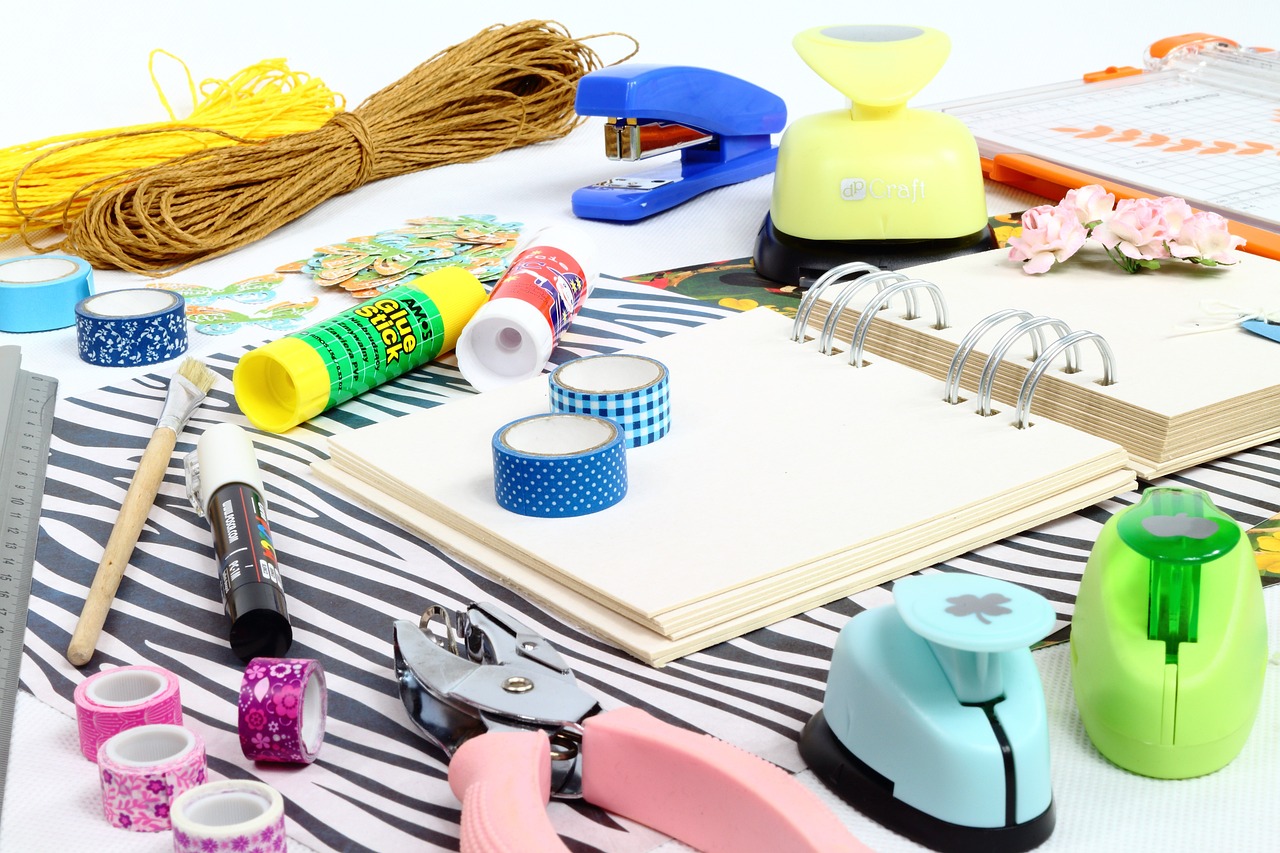Origami Crafts That Help Kids Improve Math Skills
Origami, the ancient art of paper folding, is not just a creative outlet; it’s a powerful tool for enhancing children's mathematical skills. Imagine your child transforming a simple piece of paper into a beautiful crane or a complex geometric figure, all while unknowingly sharpening their math abilities. This hands-on activity engages them in a way that traditional math lessons often cannot. By folding paper into various shapes, children intuitively grasp essential mathematical concepts, making learning both fun and effective. It’s like turning a mundane math class into an exciting adventure where every fold and crease opens up a world of possibilities!
At its core, origami is steeped in mathematical principles. Each fold involves understanding symmetry, angles, and geometric shapes. When children engage in origami, they’re not just creating art; they’re exploring the very fabric of mathematics. For instance, when they fold a square into a triangle, they’re learning about fractions and how shapes relate to one another. This connection between origami and math is a beautiful example of how art can enhance scientific understanding.
Participating in origami offers a myriad of benefits beyond just math skills. It significantly boosts children’s fine motor skills, concentration, and patience. These skills are essential as they contribute to overall cognitive development. Picture this: as your child meticulously folds paper, they are not only improving their dexterity but also learning the value of perseverance. This process fosters a love for learning, turning what could be a tedious task into an enjoyable challenge.
One of the most significant advantages of origami is its ability to enhance spatial awareness. When children manipulate paper to create three-dimensional shapes, they are developing the ability to visualize and understand how objects fit together in space. This skill is not only crucial for success in STEM subjects but also for everyday problem-solving. Think of it as giving them a mental toolbox filled with the skills they need to tackle real-world challenges.
Folding paper into various shapes introduces children to geometric concepts, such as congruence and symmetry. This hands-on experience makes learning geometry more tangible and enjoyable. Instead of just reading about shapes in a textbook, kids can see and feel these concepts come to life right in front of them. It’s like turning abstract ideas into concrete realities, making the learning process much more engaging.
Origami encourages kids to think critically and creatively as they work through folding instructions. This not only enhances their problem-solving abilities but also builds resilience when faced with challenges. Each time they encounter a tricky fold or an unexpected result, they learn to adapt and find solutions. It’s akin to navigating a maze; sometimes you hit a dead end, but with perseverance, you find a way out. This mindset is invaluable, not just in math but in life.
As children immerse themselves in origami, they naturally pick up new mathematical terms related to shapes, angles, and measurements. This enrichment of vocabulary enhances their understanding of math concepts. It’s like adding new tools to their mental toolbox, allowing them to articulate their thoughts and ideas more clearly. The more they practice, the more fluent they become in the language of math, which is essential for their future academic success.
Teachers can seamlessly integrate origami into their math curriculum, transforming lessons into interactive and engaging experiences. By incorporating origami activities, educators provide students with a unique way to explore mathematical concepts. It’s not just about solving problems on paper anymore; it’s about bringing math to life through creativity and exploration.
Educators can design lesson plans that include origami activities, helping students apply math concepts in a practical context. For example, a lesson on angles could involve folding paper to create different geometric shapes, allowing students to see the angles in action. This approach not only fosters creativity but also encourages collaboration among students as they work together to create their origami masterpieces.
Origami can serve as an effective teaching tool, allowing teachers to demonstrate mathematical principles through hands-on activities that captivate students' interest. By engaging with origami, students are more likely to remember the concepts they’ve learned, as they’ve experienced them firsthand. It’s like having a secret weapon in the classroom that makes math not just a subject to study, but an adventure to embark upon.
- How does origami improve math skills? Origami enhances spatial reasoning, geometry understanding, and problem-solving skills through hands-on activities.
- What age group is best for origami? Children of all ages can benefit from origami, but it is particularly effective for elementary and middle school students.
- Can origami be used in other subjects? Absolutely! Origami can be integrated into art, science, and even language lessons to promote creativity and critical thinking.

The Connection Between Origami and Math
Origami, the ancient art of paper folding, is not just about creating beautiful shapes; it’s a fascinating intersection of art and mathematics. When children engage in origami, they unknowingly dive into a world filled with symmetry, angles, and geometric shapes. Imagine this: as they fold a simple piece of paper into a crane, they are not just following instructions; they are actively participating in a mathematical dialogue. This dialogue helps them grasp fundamental math principles while enjoying a hands-on activity that stimulates both their minds and their creativity.
At its core, origami is an excellent tool for teaching various mathematical concepts. For instance, when children fold paper, they often encounter symmetry—the idea that one side mirrors the other. This concept is crucial not only in art but also in mathematics, where symmetry plays a significant role in geometry. Additionally, by manipulating paper, kids learn about angles and how different folds create new shapes, thereby enhancing their understanding of spatial relationships. In fact, studies have shown that engaging in origami can significantly improve a child's ability to visualize and manipulate three-dimensional objects, a skill that is essential for success in STEM (Science, Technology, Engineering, and Mathematics) fields.
Moreover, origami introduces children to a variety of geometric concepts, such as congruence and transformation. When they fold a piece of paper, they can see and feel how shapes change and relate to one another. This tactile experience makes learning geometry more tangible and enjoyable. For example, when a child folds a square into a triangle, they are not only creating a new shape but also learning about the properties of each shape involved. This hands-on approach demystifies mathematical concepts, making them accessible and engaging.
In addition to geometry, origami also fosters critical thinking and problem-solving skills. As children follow folding instructions, they must think critically about each step. They learn to anticipate the outcome of their folds, which encourages them to visualize the process and make adjustments as necessary. This kind of thinking is akin to solving a puzzle, where each piece must fit together perfectly to create the final picture. As they navigate through challenges in their origami projects, kids develop resilience and a growth mindset—qualities that are invaluable in both academic and everyday situations.
In summary, the connection between origami and math is profound and multifaceted. Through the art of folding paper, children explore essential mathematical concepts while enhancing their cognitive abilities. The beauty of origami lies not only in the final product but also in the learning journey it offers. So, the next time you see a child folding paper, remember that they are not just playing; they are engaging in a creative process that strengthens their mathematical skills in a fun and meaningful way.

Benefits of Origami for Children
Engaging in origami is not just about folding paper into beautiful shapes; it’s a gateway to a plethora of benefits that can significantly enhance a child's development. Imagine a world where math and art collide, creating a vibrant space for learning! Origami offers a unique blend of creativity and analytical thinking that can help children grow in various ways. For starters, it boosts fine motor skills as kids practice precise movements while folding, which is essential for tasks like writing and using scissors. This hands-on activity demands concentration and patience, qualities that are vital in both academic and everyday life.
Moreover, origami is a fantastic way to improve cognitive development. Children learn to follow instructions step-by-step, which enhances their ability to focus on tasks and complete them successfully. Think of it as a puzzle; every fold is a piece that contributes to the final picture. This process not only sharpens their attention span but also fosters a sense of accomplishment once they see their creation take shape. In a world where instant gratification is the norm, origami teaches the value of patience and the rewards that come from persistence.
Another remarkable benefit of origami is its ability to enhance spatial awareness. As children manipulate paper into three-dimensional shapes, they develop a better understanding of how objects fit together in space. This skill is crucial for success in STEM (Science, Technology, Engineering, and Mathematics) subjects. For instance, when a child folds a paper into a cube, they begin to visualize how two-dimensional shapes can transform into three-dimensional forms. This transformation is not just fun; it’s a fundamental concept in geometry and spatial reasoning.
Furthermore, engaging in origami encourages problem-solving skills. When kids encounter a tricky fold or an unexpected result, they are prompted to think critically and creatively. They learn to analyze the situation, consider alternative approaches, and find solutions. This resilience is a valuable life skill, preparing them to tackle challenges both in and out of the classroom. The experience of working through difficulties in origami can mirror real-life scenarios, teaching children that it's okay to struggle and that success often comes after overcoming obstacles.
In addition to these cognitive benefits, origami also enriches a child’s mathematical vocabulary. As they engage with various shapes and angles, they naturally pick up terminology related to geometry and measurements. For example, terms like "vertex," "edge," and "symmetry" become part of their everyday language. This enriched vocabulary not only aids in their understanding of mathematical concepts but also boosts their confidence when discussing math-related topics.
In summary, the benefits of origami extend far beyond the classroom. By participating in this engaging activity, children not only improve their math skills but also develop essential life skills such as patience, focus, and resilience. As they fold paper into intricate designs, they are simultaneously building a strong foundation for their future learning and personal growth. So, why not introduce your child to the wonderful world of origami? It’s a fun and educational adventure waiting to unfold!
- What age is appropriate for children to start origami?
Children as young as 4 can start with simple folds, while older kids can tackle more complex designs. - Do I need special paper for origami?
No, but origami paper is thinner and easier to fold. Regular printer paper can also work for beginners. - Can origami be used in teaching other subjects?
Absolutely! It can be integrated into art, science, and even language lessons to make learning more interactive.

Enhancing Spatial Awareness
When it comes to developing spatial awareness, origami is like a secret weapon in a child's learning toolkit. Imagine a world where kids can fold paper into intricate shapes and, in doing so, unlock the mysteries of three-dimensional space. By manipulating paper, children learn to visualize how different shapes fit together, rotate, and transform. This hands-on experience is not just fun; it’s a gateway to understanding complex spatial relationships that are crucial in fields like architecture, engineering, and even art.
Think about it: when a child folds a piece of paper into a crane or a boat, they are not just following instructions; they are actively engaging their brains. They must consider how each fold affects the overall shape, which is a practical application of geometry in action. This process encourages them to think critically about how objects exist in space and how they can manipulate those objects to create something new.
Moreover, origami fosters an understanding of perspective. When children create a model, they often need to visualize how it will look from different angles. This skill is essential not just in math but in everyday life. For instance, when navigating through a crowded room or figuring out how to fit furniture in a small space, strong spatial awareness can make all the difference. It’s like having a mental map that helps them navigate the world around them.
To illustrate the impact of origami on spatial awareness, consider the following table that highlights key spatial skills developed through origami:
| Spatial Skill | Description | Origami Activity |
|---|---|---|
| Visualization | The ability to imagine how shapes look from different angles. | Folding a cube from a flat sheet of paper. |
| Rotation | Understanding how shapes can be rotated in space. | Creating a rotating pinwheel. |
| Transformation | Recognizing how shapes change during folding. | Making a paper airplane and observing its flight path. |
Incorporating origami into playtime not only makes math fun but also equips kids with essential skills they will use throughout their lives. So, the next time you see a child engrossed in folding paper, remember: they are not just playing; they are building a foundation for future success in STEM fields and beyond!
- How does origami improve spatial awareness?
Origami helps children visualize and manipulate shapes, enhancing their ability to understand three-dimensional space. - Can origami be used in the classroom?
Absolutely! Teachers can integrate origami into math lessons to make learning more interactive and engaging. - What age is appropriate for introducing origami to children?
Children as young as 5 years old can start with simple origami projects, gradually progressing to more complex designs.

Understanding Geometry Through Folding
When we think about geometry, we often picture complex equations and abstract concepts that can feel intimidating, especially for kids. However, origami transforms these ideas into something tangible and fun. By folding paper into various shapes, children experience geometry in a hands-on way that deepens their understanding of fundamental principles. For instance, when a child folds a piece of paper in half, they are not just creating a crease; they are actively engaging with the concept of lines of symmetry and congruence.
Through origami, kids can explore geometric shapes like triangles, squares, and rectangles, and see how they can be manipulated to form more complex structures. This process of folding encourages them to think critically about how shapes relate to one another. As they fold, they can observe how different angles come together, which ignites curiosity about acute, obtuse, and right angles. It’s like giving them a set of building blocks to construct their understanding of geometry from the ground up!
Moreover, origami introduces children to spatial reasoning, an essential skill in geometry. When kids fold paper, they are essentially translating two-dimensional shapes into three-dimensional forms. This transition helps them visualize how shapes can interact in space, making it easier to grasp concepts such as volume and surface area later on. To illustrate, consider the following geometric concepts that can be taught through origami:
- Symmetry: Folding a paper butterfly demonstrates bilateral symmetry, allowing kids to see how one side mirrors the other.
- Angles: The folds required to create a paper crane can introduce children to different angles and how they are formed.
- Polygons: Origami can be used to create various polygons, helping children understand the properties of shapes like pentagons and hexagons.
By engaging with these concepts through origami, children are not just memorizing definitions; they are experiencing geometry in a way that is interactive and memorable. As they create intricate designs, they develop a sense of accomplishment that can boost their confidence in math. This fusion of creativity and learning can be incredibly powerful, making geometry feel less like a chore and more like an adventure.

Developing Problem-Solving Skills
Origami is not just about folding paper into beautiful shapes; it’s a fantastic way to develop critical problem-solving skills in children. When kids engage in origami, they are presented with a series of challenges that require them to think critically and creatively. Each fold in the paper is a step in a journey, and sometimes that journey can take unexpected turns. Imagine your child attempting to create a crane, only to realize halfway through that they misread the instructions. Instead of giving up, they must analyze what went wrong, assess their options, and find a solution. This process mirrors real-life problem-solving scenarios and encourages resilience.
Moreover, origami encourages children to break down complex tasks into manageable steps. When faced with intricate designs, they learn to approach problems methodically. For instance, if they want to create a multi-layered flower, they must first understand the basic shapes and folds required to build up to the final product. This not only enhances their logical thinking but also teaches them the importance of patience and perseverance.
As they fold and refold, children are also practicing the art of trial and error. They might fold a piece of paper incorrectly, but rather than seeing this as a failure, they learn that mistakes are simply opportunities for learning. This mindset is invaluable, as it fosters a growth-oriented approach to challenges in all areas of life, whether in academics or personal endeavors.
To illustrate how origami enhances problem-solving skills, consider the following key aspects:
- Critical Thinking: Children analyze instructions and make decisions on how to proceed.
- Creativity: They are encouraged to think outside the box, creating unique designs.
- Resilience: Learning to overcome challenges boosts their confidence in tackling future problems.
In essence, origami serves as a powerful tool for developing problem-solving skills. It provides a hands-on experience that is both engaging and educational, allowing children to navigate challenges with confidence. As they manipulate paper into stunning creations, they are simultaneously honing their ability to approach and resolve problems creatively and effectively.
- How does origami help with math skills? Origami incorporates various mathematical concepts such as geometry, symmetry, and spatial reasoning, making math more tangible and enjoyable for children.
- Can origami be taught in schools? Absolutely! Many educators are integrating origami into their lesson plans to create interactive and engaging math lessons.
- What age is appropriate for children to start learning origami? Children as young as 5 can start with simple designs, while older kids can tackle more complex projects.
- Does origami improve fine motor skills? Yes, the precise movements involved in folding paper help improve fine motor skills and hand-eye coordination.

Boosting Mathematical Vocabulary
Engaging in origami is not just about the joy of folding paper into beautiful shapes; it also serves as a fantastic way to boost children's mathematical vocabulary. As kids dive into the world of origami, they encounter a variety of terms that are fundamental to understanding mathematics. For instance, while folding a simple origami crane, children learn about concepts such as angles, vertices, and symmetry. These terms are not just words; they are the building blocks of mathematical understanding, helping children articulate their thoughts and ideas more clearly.
Moreover, the hands-on nature of origami allows children to experience these mathematical concepts in a tangible way. Imagine a child folding a paper into a triangle and then discussing the properties of triangles—they're not just memorizing definitions; they are actively engaging with the material. This active participation aids in retention and understanding, making the learning process both effective and enjoyable.
Additionally, as children progress to more complex origami designs, they are introduced to even more advanced vocabulary. Terms like congruence, parallel lines, and transformation come into play, enriching their linguistic and mathematical skills simultaneously. The beauty of this approach is that it seamlessly integrates language learning with math, making it feel less like a chore and more like a fun challenge.
To further illustrate the impact of origami on mathematical vocabulary, consider the following table:
| Origami Term | Mathematical Concept | Example in Origami |
|---|---|---|
| Symmetry | A property where one half is a mirror image of the other | Folding a paper in half to create a symmetrical shape |
| Angle | The space between two intersecting lines | Creating folds that form acute or obtuse angles |
| Vertex | A point where two or more lines meet | The corners of a folded paper shape |
| Congruence | Having the same size and shape | Folding two identical shapes |
Incorporating these terms into everyday conversation about origami not only enhances children's vocabulary but also builds their confidence in using mathematical language. When they can articulate what they are doing and why, it creates a deeper understanding of the subject matter. The more they practice, the more fluent they become in both math and language, paving the way for future academic success.
Ultimately, the way origami intertwines creativity with mathematics makes it a unique educational tool. It's like finding a hidden treasure where kids can discover not just the joy of folding paper but also the richness of mathematical vocabulary that comes along with it. So, the next time you see a child folding a paper crane, remember—they're not just playing; they’re also building a robust foundation for their mathematical journey!
- How does origami improve math skills? Origami enhances spatial reasoning, geometry understanding, and problem-solving abilities through hands-on folding activities.
- What age group is best for origami? Children of all ages can benefit from origami, but it is particularly effective for elementary school students.
- Can origami be used in math lessons? Absolutely! Teachers can incorporate origami into their curriculum to make math lessons more interactive and engaging.
- What materials do I need to start with origami? All you need is some paper! You can use origami paper, but any square piece of paper will work.

Incorporating Origami into Math Lessons
Integrating origami into math lessons can transform a typical classroom experience into an exciting adventure of discovery. By using paper folding as a hands-on activity, educators can create a dynamic learning environment that captivates students' attention and encourages them to explore mathematical concepts in a fun and engaging way. Imagine a classroom where students are not just sitting behind desks, but actively participating in their learning through the art of folding paper!
One of the most effective ways to incorporate origami into math lessons is by designing lesson plans that align with specific mathematical objectives. For instance, when teaching geometry, educators can introduce origami projects that require students to create shapes like triangles, squares, and even more complex figures. This hands-on approach not only makes the learning process enjoyable but also helps students visualize and understand the properties of these shapes in a practical context.
Furthermore, origami can be used to illustrate various mathematical principles, such as symmetry, angles, and congruence. When students fold paper to create symmetrical designs or explore the angles involved in each fold, they are engaging in a form of experiential learning that solidifies their understanding of these concepts. For example, a simple origami crane can serve as a perfect illustration of how angles work together to create a cohesive shape, thereby enhancing students' comprehension of geometry.
To effectively implement origami in the classroom, teachers might consider the following strategies:
- Start with Simple Projects: Begin with easy origami models that are age-appropriate, allowing students to gain confidence in their folding skills before tackling more complex designs.
- Connect to Curriculum: Align origami projects with current math topics, ensuring that the activity reinforces the lessons being taught.
- Encourage Collaboration: Promote teamwork by having students work in pairs or small groups to complete origami tasks, fostering communication and collaboration skills.
Additionally, origami can be a powerful tool for cross-curricular learning. For instance, while folding paper, students can also explore concepts from art, such as color theory and design, or delve into history by learning about the cultural significance of origami in different societies. This interdisciplinary approach not only enriches students' learning experiences but also helps them see the connections between different subjects, making their education more holistic.
In conclusion, incorporating origami into math lessons is not just about teaching students how to fold paper; it's about creating an interactive learning environment that fosters critical thinking, creativity, and a deeper understanding of mathematical concepts. By embracing this innovative approach, educators can inspire a love for math that will last a lifetime.
Q: How can origami help improve math skills?
A: Origami enhances spatial awareness, geometry understanding, and problem-solving skills through hands-on experiences that make learning enjoyable.
Q: What age group is suitable for origami activities?
A: Origami can be adapted for various age groups, from young children to older students, with projects tailored to their skill levels.
Q: Can origami be used in subjects other than math?
A: Yes! Origami can be integrated into art, history, and even science lessons, making it a versatile educational tool.

Creating Lesson Plans
Integrating origami into math lessons can transform a standard classroom experience into an exciting adventure filled with creativity and discovery. When educators design lesson plans that incorporate origami activities, they provide students with a unique opportunity to apply mathematical concepts in a tangible way. Imagine a classroom where students are not just learning about shapes and angles from a textbook, but actively creating them with their own hands! This hands-on approach not only makes learning more enjoyable but also reinforces the concepts they are studying.
To create effective lesson plans, teachers should first identify the mathematical concepts they wish to focus on. For instance, if the aim is to teach geometry, they might select origami projects that involve creating shapes like triangles, squares, or more complex polygons. By folding paper into these shapes, students can visually and physically explore properties like symmetry, congruence, and angles. This tactile experience makes abstract concepts much more relatable.
Here’s a simple framework that educators can follow when creating their origami lesson plans:
| Step | Description |
|---|---|
| 1. Define Objectives | Clearly outline what mathematical concepts you want students to learn through origami. |
| 2. Choose Origami Projects | Select origami models that align with the defined objectives, ensuring they vary in difficulty to cater to different skill levels. |
| 3. Prepare Materials | Gather all necessary materials, including different sizes and colors of paper, scissors, and instructional handouts. |
| 4. Introduce the Activity | Begin the lesson by explaining the mathematical concepts involved in the origami project, emphasizing how folding relates to geometry. |
| 5. Hands-On Folding | Guide students through the folding process, encouraging them to ask questions and express their thoughts as they work. |
| 6. Reflection | Conclude the lesson by discussing what students learned, allowing them to share their creations and insights about the math involved. |
By following this structured approach, teachers can ensure that their origami lessons are not only educational but also engaging. Additionally, incorporating group activities can foster collaboration among students, as they can work together to tackle more complex origami projects. This collaboration not only enhances their social skills but also promotes a deeper understanding of mathematical concepts as they discuss and problem-solve together.
Ultimately, the goal is to create an environment where students feel empowered to explore math in a fun and creative way. When they see how math is present in the art of origami, it sparks curiosity and a desire to learn more. So, let’s fold our way into a world of math where every crease brings us closer to understanding!
- What age group is suitable for origami activities in math lessons? Origami can be adapted for various age groups, but it is particularly effective for elementary and middle school students, as it aligns well with their developmental stages.
- Do I need special materials for origami? While traditional origami paper is ideal, any square or rectangular paper can be used. Colored paper can make the activity more engaging for students.
- How can origami help with other subjects? Besides math, origami can enhance skills in art, science (understanding symmetry in nature), and even history (exploring the cultural significance of origami).
- Can origami be integrated into online learning? Absolutely! Many origami tutorials are available online, allowing students to participate in virtual origami lessons from home.

Using Origami as a Teaching Tool
Origami isn't just about folding paper into beautiful shapes; it’s a dynamic teaching tool that can transform the way children learn math. By incorporating origami into the classroom, educators can create a vibrant and interactive learning environment that captivates students' attention. Imagine a classroom where students are not just passive recipients of information but active participants in their learning journey. This hands-on approach fosters a deeper understanding of mathematical principles while making the learning process enjoyable.
One of the most compelling aspects of using origami in education is its ability to make abstract mathematical concepts more concrete. For example, when students fold paper into geometric shapes, they are not just engaging in a craft; they are exploring angles, symmetry, and congruence in a tangible way. This practical application of math helps students visualize and internalize concepts that might otherwise seem daunting. When they see a triangle emerge from a flat piece of paper, they can better grasp the properties of triangles, such as the sum of angles and the relationship between sides.
Moreover, origami encourages collaboration and communication among students. When working in groups, children must discuss their folding techniques and problem-solving strategies. This interaction not only enhances their social skills but also promotes critical thinking. As they navigate through challenges—like figuring out how to create a complex shape—students learn to persevere and think outside the box. The process of trial and error in origami mimics real-life problem-solving scenarios, teaching kids that making mistakes is a natural part of learning.
To illustrate the effectiveness of origami as a teaching tool, consider the following table that outlines key benefits:
| Benefit | Description |
|---|---|
| Visual Learning | Helps students visualize mathematical concepts through hands-on activities. |
| Collaboration | Encourages teamwork and communication among students. |
| Problem-Solving | Enhances critical thinking skills by challenging students to overcome obstacles. |
| Engagement | Captivates students' interest, making learning fun and interactive. |
Incorporating origami into lesson plans can be as simple as dedicating a few minutes at the start of a math class to a quick origami project. As students fold, teachers can introduce relevant mathematical vocabulary and concepts, seamlessly blending art with mathematics. For instance, while creating a paper crane, students can learn about symmetry by folding the paper in half and discussing how each side mirrors the other. This kind of engaging activity not only reinforces math skills but also allows children to express their creativity.
In conclusion, using origami as a teaching tool can revolutionize math education. It transforms a traditionally abstract subject into a lively, interactive experience that promotes understanding and retention. By blending creativity with critical thinking, origami empowers students to embrace mathematics with enthusiasm and confidence, paving the way for a brighter future in STEM fields.
- How does origami improve math skills? Origami enhances spatial reasoning, geometry understanding, and problem-solving skills through hands-on folding activities.
- Can origami be integrated into other subjects? Yes! Origami can also be used in art, science, and even history lessons to teach various concepts.
- What age group is best suited for origami activities? Origami can be enjoyed by children of all ages, with varying levels of complexity tailored to their skill levels.
Frequently Asked Questions
- How does origami help improve math skills in children?
Engaging in origami helps children grasp essential mathematical concepts such as geometry, symmetry, and spatial reasoning. As they fold paper into various shapes, they apply these concepts practically, making math more relatable and enjoyable.
- What are the specific math skills enhanced by origami?
Origami enhances several math skills, including:
- Spatial Awareness: Helps children visualize and manipulate three-dimensional shapes.
- Geometry Understanding: Introduces concepts like congruence and symmetry through hands-on folding.
- Problem-Solving: Encourages critical thinking as kids follow complex folding instructions.
- Can origami be integrated into classroom lessons?
Absolutely! Teachers can incorporate origami into their math curriculum to create engaging and interactive lessons. This approach not only makes learning fun but also helps students apply math concepts in real-world scenarios.
- What age group is best suited for origami activities?
Origami can benefit children of various ages, typically starting from around 5 years old. It's a versatile activity that can be adjusted to suit different skill levels, making it perfect for early learners and older students alike.
- Are there specific origami projects recommended for teaching math?
Yes! Some great origami projects for teaching math include:
- Origami Squares: Helps with understanding area and perimeter.
- Origami Triangles: Introduces concepts of angles and congruence.
- Origami Boxes: Teaches volume and surface area in a fun way.
- How does origami promote fine motor skills?
Folding paper requires precision and control, which helps children develop fine motor skills. These skills are essential for tasks such as writing, drawing, and other activities that require hand-eye coordination.
- Is there any research supporting the benefits of origami in education?
Yes, numerous studies have highlighted the educational benefits of origami, linking it to improved spatial reasoning, enhanced problem-solving abilities, and increased engagement in math learning. It's a fantastic way to bridge creativity and education!



















